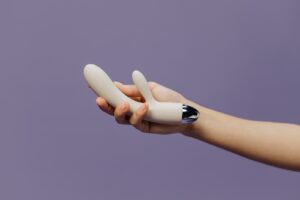IUDs are a popular method of birth control because they’re low maintenance and over 99% effective at preventing pregnancy. And, they’re a great choice for women of all ages.
However, if an IUD moves during sex, it’s important to know what to do. Fortunately, it’s extremely rare for sex to dislodge an IUD or cause it to move out of place.
How to check
For an IUD to do its job of effectively preventing pregnancy, it’s got to be secure in your uterus. That’s why ob/gyns encourage women to check the thin strings (think short pieces of fishing line) attached to it once or twice per month and before each sexual encounter.
To do this, sit or squat, and stick your index finger in your vagina to feel for your cervix. It’ll feel firm and rubbery, sort of like the tip of your nose. From there, slide your finger into the opening of your uterus and locate the strings. They should be around the same length as your index finger.
If you’re feeling something that doesn’t quite sound right, don’t panic. Your partner’s penis is unlikely to knock out or shift your IUD because, well, it just isn’t that big of a deal unless there’s more going on than a little fling.
However, if you are experiencing pain during sex, it could indicate that your IUD has moved to a position where it’s not supposed to be. If it’s a new sensation or the pain is severe, call your doctor immediately and start using emergency contraception. If your IUD is displaced, embedded in the sides of your uterus, or even expelled, it’s considered a medical emergency and can put you at risk for ectopic pregnancy, which is dangerous to both you and the unborn baby.
Symptoms
IUDs are small, T-shaped devices that prevent pregnancy by blocking sperm from reaching your egg. They are inserted inside the uterus, which means they’re outside the penetration zone for sex, so sex is unlikely to cause your IUD to move or fall out (called expulsion).
In fact, most women who have IUDs don’t feel them at all during sex. And if you or your partner feel them, that’s probably a sign that the IUD has moved from its correct place.
That’s why it’s important to check your IUD’s strings every month by washing your hands and inserting a finger into your vagina. Feel for the hard area at the top, which is your cervix. The string should stick out 1-2 inches from there. If it feels shorter or disappeared altogether, that’s a clear indicator that something is wrong, says Dr. Minkin.
Another symptom of IUD movement is pain during sex that doesn’t go away with ibuprofen or naproxen. If you start to notice this, it’s a good idea to call your doctor and ask for an appointment to make sure your IUD is still where it’s supposed to be. If it has moved, they’ll help you figure out if and when you should use a backup birth control method to avoid pregnancy.
Expulsion
The location of your IUD, as well as sex type, can affect whether or not you feel your strings. But if you have an IUD, even the most enthusiastic sex positions shouldn’t displace your IUD or cause it to fall out of your uterus (what healthcare professionals call expulsion). Even if your partner’s penis reaches the strings, it shouldn’t hurt you—but it may give off a tickle.
A medical professional may be able to help you get your IUD back into place if it’s been expelled, but a new one would need to be inserted. During an expulsion, your healthcare provider would use a speculum to find the cervix and then ring forceps to grasp the IUD strings and pull it out. This process is very quick, painless and relatively inexpensive.
However, it’s important to check your IUD strings on a regular basis—especially during your period and right before sexual activity. A misplaced IUD cuts your uterus near important blood vessels and can lead to bleeding, complications with your birth control, inflammatory reactions, and even bowel perforations in rare cases. If you’re unsure of where your IUD is, schedule an appointment with your OB-GYN. They can perform an ultrasound and make sure your IUD is where it’s supposed to be. In some cases, they might suggest alternative methods of birth control.
Perforation
An IUD is a small T-shaped plastic and copper device that’s fitted into your womb (uterus) by a trained doctor or nurse at your GP practice or sexual health clinic. It’s a long-acting, reversible contraceptive that protects against pregnancy for up to 10 years, depending on the type.
It’s rare for an IUD to perforate the uterus, but it can happen, and it’s more likely with certain types of IUDs, including levonorgestrel-releasing IUDs or copper IUDs. This happens less than 1 in 1,000 insertions. It usually happens during or shortly after insertion and might not be noticed for weeks or months.
Symptoms of perforation include pelvic pain, vaginal bleeding, pain or discomfort during sexual activity and fever. It can also lead to a serious pelvic infection called pelvic inflammatory disease, or PID. This can cause long-lasting pelvic pain, bloody or cloudy vaginal discharge and chills.
If you think you’ve had a perforated IUD, contact your GP or sexual health team immediately. They can check if your IUD is still in place by feeling the threads. Then, they might be able to cut the threads to a shorter length so you can’t feel them anymore. They’ll also talk to you about treatment options, which may include surgery to remove the device and repair any damage to your uterus.
See Also:






